Fortified maize meal improves vitamin A and iron status in refugees
Summary of published field trial1

Premixing at the refugee camp site
Nangweshi refugee camp was opened in 2000 in response to the influx of refugees fleeing the Angolan civil war. It is located in Western Province of Zambia, about 180 km from the border with Angola. The population figure for June 2003 was recorded by the United Nations High Commissioner for Refugees (UNHCR) as 26,061, with 8,404 households. The planned ration supplied by the World Food Programme (WFP) comprised maize meal, pulses, vegetable oil and salt. An initial analysis of the food aid basket was performed to assess the likely prevalence of micronutrient deficiencies. This showed that the ration was deficient in a number of micronutrients including vitamin A, iron (Fe), riboflavin and vitamin C. High-dose vitamin A capsules were distributed periodically to children in the camp and Fe/folate tablets were available for pregnant women via the antenatal care programme.

Milling on site at the refugee camp
Using custom designed mobile milling and fortification equipment, maize meal fortification was field tested in the camp at the beginning of 2003. The equipment was shipped to the camp where it was installed and operated at a central location. The production staff were members of the refugee population, while programme management was undertaken by Care International. A key aspect of this intervention was that maize meal fortified in a country of origin may only have a limited shelf-life of a few weeks, due to the rapid onset of fat rancidity in tropical temperatures and humidity. This recently published paper describes the outcome of the field trial.

Blood sampling during the household survey
The objective of the trial was to assess changes in Fe and vitamin A status of the population of Nangweshi refugee camp, associated with the introduction of maize meal fortification. Maize grain was milled and fortified in custom-designed mills installed at a central location in the camp. A daily ration of 400g per person was distributed twice monthly to households as part of the routine food aid ration. The trial was a pre- and post-intervention study using a longitudinal cohort. It was not possible to include a control group owing to the geographical layout of the camp and logistics, as well as operational and ethical considerations. Two hundred and twelve adolescents (10-19 years), 157 children (6-59 months) and 118 women (20-49 years) were selected at random by household survey in July 2003 and followed up after 12 months.
The study found that during the intervention period, mean haemoglobin (Hb) increased in children (0.87 g/dl; P <0.001) and adolescents (0.24 g/dl; P= 0.043) but did not increase in women. Anaemia decreased in children by 23.4% (P<0.001) but there was no significant change in adolescents or women. In adolescents, serum retinol increased by 0.16 ?mol/l (P<0.001) and vitamin A deficiency decreased by 26.1% (P<0.001).

Weighing out the premix.
The authors concluded that there was a clear association between the introduction of fortified maize meal and an improvement in the Fe and vitamin A status of a food aid-dependent refugee population. Improvements in the status of adolescents and a reduction in anaemia in children are important public health gains. Furthermore, although no information was collected on other micronutrient deficiencies, it is likely that the study population was deficient in a number of other micronutrients. In particular, vitamin B deficiency is frequently found in maize consuming populations and health staff in the camp reported isolated clinical cases of pellagra during the intervention period. Niacin and other B vitamins were included in the maize meal fortificant and it is reasonable to assume that this will have led to improvements in the micronutrient status of the population.
The authors also suggest that this type of food aid fortification is an effective means of reducing childhood anaemia and improving adolescent Fe and vitamin A status in highly vulnerable, aid-dependent populations, although its impact on anaemia in women remains unclear. The data suggest that local level, centralised milling and fortification of staple foods should be promoted and their nutritional impact and cost-effectiveness investigated in other operational contexts.
1Seal. A et al (2007). Maize meal fortification is associated with improved vitamin A and iron status in adolescents and reduced childhood anaemia in a food aid-dependent refugee population. Public Health and Nutrition, pp 1-9
Imported from FEX website


